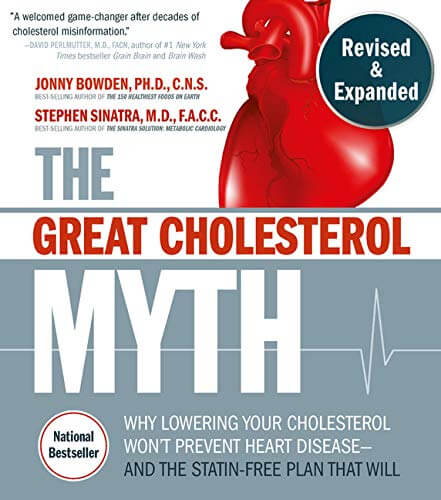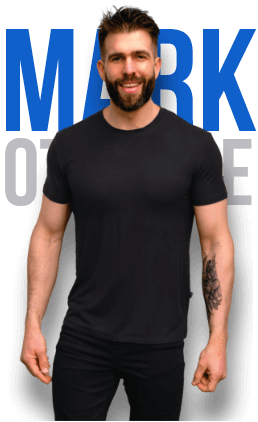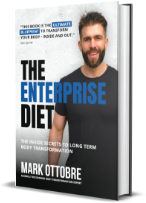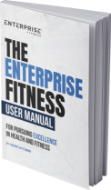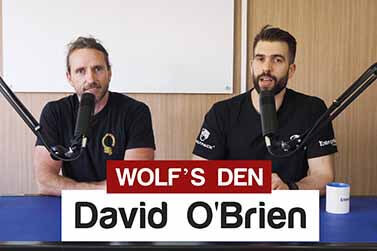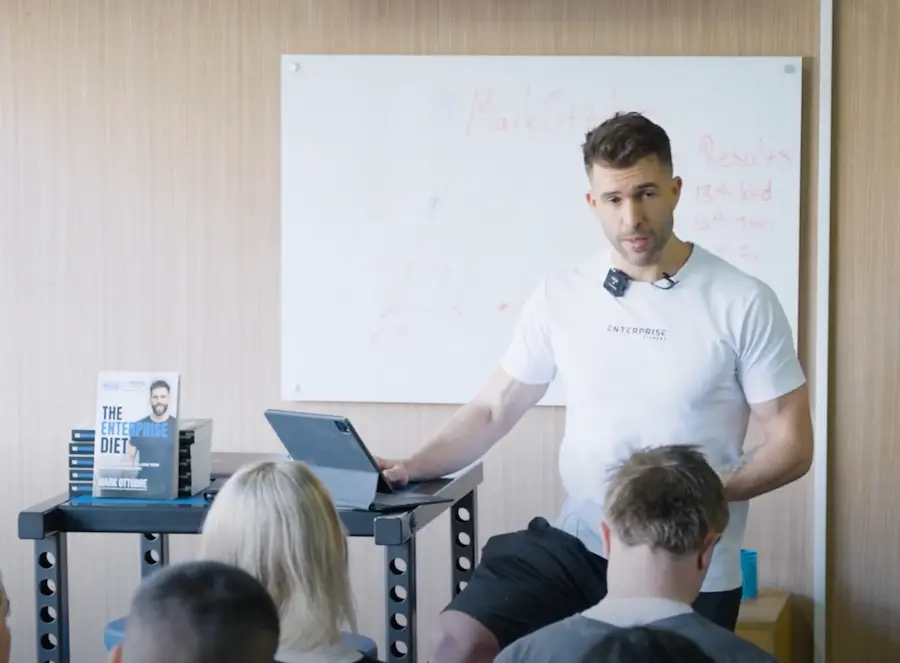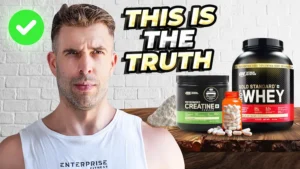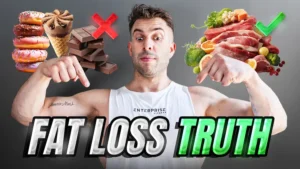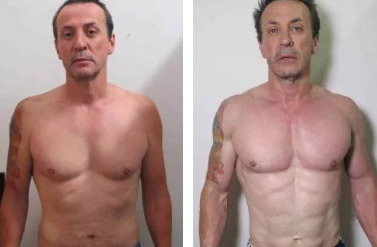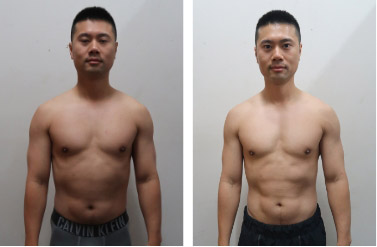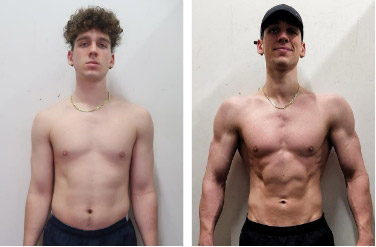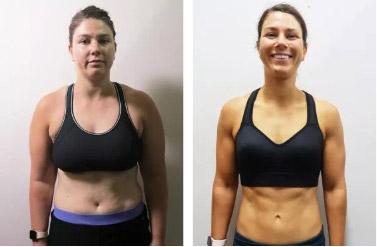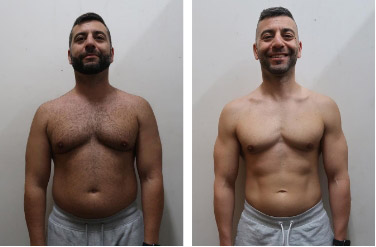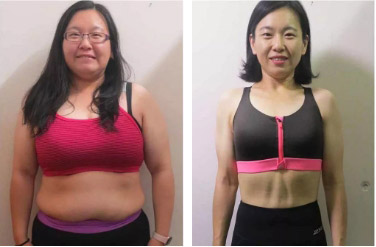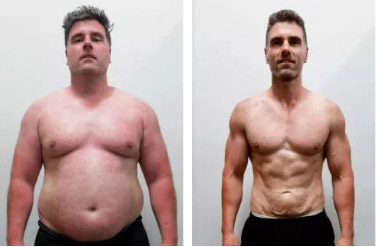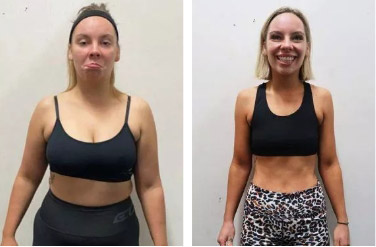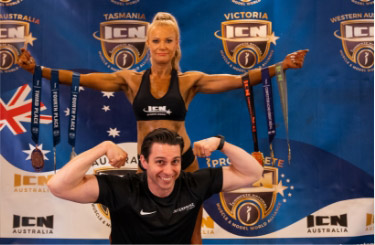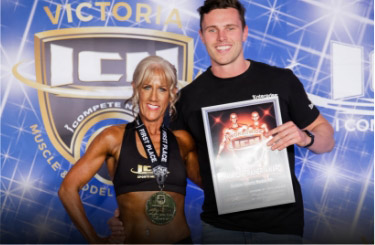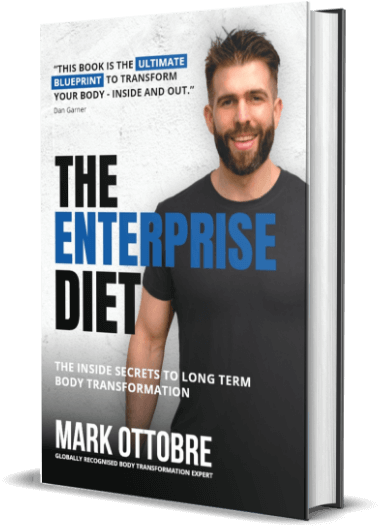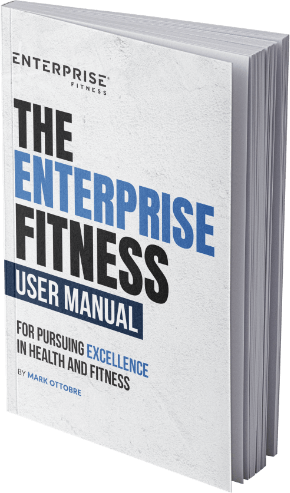In this podcast, I interview Jonny Bowden, author of The Great Cholesterol Myth
I consider Jonny Bowden the Michael Jordan of the nutrition.
Jonny has authored 15 best selling books, including the 150 Healthiest Foods on Earth series. In this podcast we chat about the re-release of his book, The Great Cholesterol Myth.
The book was first written in 2010 and later published in 2012. The reason Jonny wanted to republish the book was because of the research published between 2012 and 2018 showing that the standard cholesterol tests your getting from your doctor are frankly useless.
In his words, it’s like using a flip-phone in 2020. Hello, iPhone 12!
Joined by Enterprise Team members and Wolfpack students, we cover The Great Cholesterol Myth and so much more. Jonny goes into all the science and the data as you would expect in covering a medical topic. The Great Cholesterol Myth coauthor is Stephen Sinatra who is a world-leading cardiologist. So this book comes packed with some heavy hitters in the field.
To tune into the episode on SoundCloud click here
To tune in on iTunes click here
Or use the player below:
And if you would be so kind, please leave the show a review and show us some love!
Every review really helps get our show ranked to spread the word of health far and wide.
YouTube:
Transcription of Wolfs Den episode, The Great Cholesterol Myth:
Mark:
It’s so great to speak to you, and have you on, and all that good stuff. I think the last time we spoke was in 2012.
Jonny Bowden:
Yes. Was it really that long?
Mark:
I think it was. I think it was actually that long. It’s actually a pleasure to have you. There’s going to be more people joining us as we go along today. Just so you know, we’ve got our enterprise crew on. Some of our enterprise trainers. We’re going to have that wolf pack on as well. So, it’ll be quite the call. I introduced you to everyone. Yesterday I was telling my team about you and your work. I introduced you as the Michael Jordan of nutrition.
Jonny Bowden:
As the what?
Mark:
The Michael Jordan-
Jonny Bowden:
The Michael Jordan of nutrition?
Mark:
Yeah.
Jonny Bowden:
Thank you. That’s quite fun. I feel like I’m not appearing in the camera right. I don’t know why. It seems like a small screen. How is that? Is that better?
Mark:
Perfect. To the folks in the chat, if you just want to give us a thumbs up, if you can hear us, just give us a yes. Awesome. Alrighty. Welcome Jonny, always great to chat with you. One of my absolute most favorite people to speak to in the world of nutrition.
Jonny Bowden:
Thank you.
Mark:
As I said, I refer to you as the Michael Jordan. You’ve been blogging since 2001. That’s 19 years and counting. You’ve authored 15 bestselling books, you’ve spoken around the world. You’ve no doubt changed countless lives. One of the things I just wanted to share before we get rocking and rolling, you’re extremely generous. I remember, it was 2008 where I wrote my first ebook, The Truth About Supplements, and I sent it to you.
I was quite young, and rashly naïve, and didn’t really know how the world worked. I just thought, “I’m just going to send it to Jonny.” You got back to me. You wrote, and you gave me words of encouragement. I’ll be forever … That’s one of the highlights, and really gave me a boost to continue on the path.
Jonny Bowden:
I had forgotten about that. Thank you so much. It’s very kind of you to mention, and to let me know that that mattered. I appreciate it.
Mark:
It really did. Even our interview … As I said, I regard you as Michael Jordan. You are Michael Jordan, what you’re to nutrition now, but he is to basketball to what you are to nutrition in my eyes.
Jonny Bowden:
Okay.
Mark:
The Truth About Supplements, I have taken it offline, because of the fact that it’s just terribly outdated. Obviously you’re all going to have your stamp for it. I want it to be on a certain level. But I am working on another book, maybe you’ll hear some months down [crosstalk 00:02:54] publish the book.
Jonny Bowden:
You let me know. Pleased to.
Mark:
Since last time we spoke it was 2012, a lot has happened-
Jonny Bowden:
Yeah.
Mark:
Too with this crazy, crazy world. I want to preface this podcast is going to be quite dynamic. I’ve got a lot of questions about different topics, and these kind of things. We are going to focus on cholesterol, following your book, which is being re-released and updated. We’ve got folks on the line-
Jonny Bowden:
Let me grab it because I don’t think it’s showing up in the back. The shameless fog, this is the book.
Mark:
Absolutely. Plug Away, it was first released in 2012, was it? Am I getting those dates right?
Jonny Bowden:
It was first written in 2010, or 11, which is why 10 years later we wanted to do an update. It came out in 2012, yes.
Mark:
So, the story goes, basically your publisher came to you. You had the healthiest foods on earth series. They came to you and they said, “Hi, Jonny, we’ve got an idea for you. Can you write a book about the 150 ways to lower your cholesterol.” And you were mortified, you were saying, “I don’t want to write a book on how to lower cholesterol. Are you guys crazy?”
Then some convincing, and then they wanted the cardiologist to give you the credentials to go and put it forward. 10 years on, what made you feel you need to revise it? What was the thing that you thought, “I need to revise this.”
Jonny Bowden:
Well, I mean, first of all, the research in this area, heart disease, cholesterol, anything that’s really pressing, there is a lot of research. A decade is a long time. I mean, a lot of stuff has come out since in a lot of, not only studies, and theories, and changes in the way we practice, and discovery of different tests, and markers, and genetics, and all the other stuff. But there’s also been quite a shift in the response to what we were talking about in the book.
We meet doctors in conferences all the time now, who say, “You have literally changed the way we practice. I’ve got your books in my waiting room. I had no idea.” Now, they’re not the majority. The majority of doctors still think we should be the equivalent of disbarred, and they write letters to doctors, like how could you have these cracks on? That’s the majority.
There is such a growing minority of people who have come onboard with the notion that cholesterol testing is, as we do it now, good and bad cholesterol is completely obsolete. A lot of people come onboard with the notion that cholesterol doesn’t cause heart disease. Since 2010, which is really when we wrote the book, that’s when the research started coming out, that saturated fat has no causal relationship to heart disease.
The study was in 2010. The American Journal of Clinical Nutrition still quote it to this day. 347,000 patients, no causal relationship. Then they started coming up fast and furious, 2014 was the Annals of Internal Medicine, no relationship between saturated fat and heart disease. Just last year there was a big study in Malaysia, where they looked at dietary patterns, low fat, high fat, low carb, high carb.
They found that in terms of metrics for heart disease, when you look at the ones that really mattered, the only thing in the diet that made a difference is carbohydrates. It didn’t if they were on low fat diet, high fat diet, their risk, still it correlated with the amount of carbohydrates in their dietary pattern.
So this stuff in the last decade, there’s been just an awful lot of research, and theory on the subject. It’s leaning the way we said it was going to lean in 2012, only more so. There is a couple of other reasons why this was so necessary. And one of them we didn’t even know when we started it, and that was COVID. I’ll get to that in a second.
When we did a deep dive, and said, “Let’s really go back and see. In 2012, the original edition we said testing cholesterol as we know it today, and I want to make sure Mark that everybody understands I’m talking about the standard test that you and I, and most people listening to get from their doctor, that’s covered by insurance.
Hdl-LDL, it’s the test that most doctors use to give you a prescription for a statin drug if your LDL is too high. That’s the test we’re talking about that should be retired. One of the goals of this book, my greatest goal, I would be so happy if it achieves this, is if they retire that test, and never again is a drug prescription ever given on the basis of HDL and LDL.
We knew that back in 2012, what we didn’t really know was what people should be testing for. We knew that there were such advanced tests like the particle test. They hadn’t been around that long, and we knew there were things like LP little A that were more important. There were all these other things. We didn’t have an absolute epiphany vision of this is what you need to look at.
Now we do. When we went back, and we looked at that research that starts in 1970, and we did a deep dive into what is it? We found that the predictors of heart disease had been hiding in plain sight for what? 50 years, and nobody talks about it. What we talk about in the new edition, the Great Cholesterol Myth, is that there is a straight line continuum in cardio metabolic diseases, by which I mean, prediabetes, metabolic syndrome, diabetes, pre-heart disease, and heart disease, one line.
The thing that connects them, the thing that shows up 10 years before your doctor says, “You know Mr. Jones, you’ve got some heart cholesterol. We might want to look at those statin drugs.” 10 years before that happens something shows up that we could all be looking at right now, and that we can treat, prevent, and reverse with diet. That’s the message of this book.
The reason it’s so relevant now in COVID, that we didn’t even know, is that every one of those diseases I just mentioned, let’s go over them again, metabolic syndrome, prediabetes, diabetes, pre-heart disease, heart disease, obesity. Every one of them is a preexisting condition that makes COVID 10 times more dangerous.
When you look at who is dying from COVID, most of them have these … Not all, there is outliers, but we’re looking at big actuarial numbers, most of them have these preconditions. These are the most vulnerable, these are the people with the immune-compromisation. These are the people who have underlying metabolic conditions that are on that straight line from prediabetes, to diabetes, to heart disease.
What shows up that predicts that? First is something called insulin resistance. It sounds like the technical term, but basically it’s an error in carbohydrate metabolism. Your body cannot handle the sugar load. What happens next is that blood sugar stays high. The body can’t bring it down with insulin, because insulin is becoming more and more ineffective. Therefore, we call it insulin resistance syndrome.
Then a direct line from that prediabetes … Make no mistake, prediabetes is diabetes. It just hasn’t quite gotten the title yet, but it’s on a continuum. Just like high blood pressure doesn’t start at 140/80. What happened to 139? It’s a continuum. It’s a continuum from diabetes to heart disease. You can nip diabetes in the bud, or at least keep it from ever getting any worse, if you treat the underlying cause, which is insulin resistance, which is just a fancy way of saying carbohydrate metabolism error.
Mark:
Every time I listen to you speak, and I have the opportunity to speak to you … I was preparing the podcast questions that I wanted to ask. I knew that I’m not going to ask any of these questions because they’re just going to roll organically, and I love it.
Jonny Bowden:
Absolutely, I love your questions, they’re smart, and you’re informed. Please, throw them at me. I’m happy to-
Mark:
An analogy I wanted to start the show with and give is cholesterol sits to me … The analogy that I like to use is, if the building was on fire the fire is inflammation, cholesterol is the firetruck that comes to quench that inflammation. Cholesterol lowering medication and drugs are essentially a terrorist with a rocket launcher, shooting the firetrucks, and blowing up the cholesterol.
Cholesterol is nothing more than a marker of inflammation, what we need to do is look under the hood. When we look under the hood, as you pointed to, with research, what we usually find is a high glucose, high insulin, high passive insulin, metabolic syndrome, diabetes. What is the best way to explain? I’ve got a lot of trainers on the line who are going to go back and ask. Clients are going to ask them the question, this term inflammation gets … Firstly, when is the analogy apt? Secondly, how do you explain inflammation as a process?
Jonny Bowden:
That’s a multi-part question. It’s a brilliant question, but it has a number of different parts. One of which is the analogy about the fire, and the claim. The other which is inflammation, how does it happen, and what does it do? Let’s start with inflammation, because that really is one of the prime drivers of … I’d have to say every degenerative disease we know of.
I don’t know of a degenerative disease, from asthma, any of the metabolic diseases we just mentioned, to cancer, to Alzheimer’s, I don’t know of any major disease like that, that does not have, as a major component, inflammation. It may not always cause a disease, but it promotes it, it makes recovery more difficult, it makes it more complicated. It is definitely one of the twin towers of cellular destruction, the other being oxidative damage.
Let’s clear up what inflammation is for people who might be unclear about it. There are really two forms of inflammation, and everyone listening to this knows form number one. Form number one is called acute inflammation. If you get a toothache, and you can feel it throbbing, and its inflect, that’s acute inflammation. You bang your knee against your wall, and it is throbbing, that’s acute inflammation. If you get an abscess on your skin, and it’s all swollen, that’s acute inflammation.
As my friend Barry Sears, the author of The Zone says, acute inflammation hurts. Chronic inflammation, which is what you and I are talking about, kills. Chronic inflammation is a relative of acute inflammation, but it flies beneath the pain radar. It’s happening at the cellular level. It’s happening in the organs, in the tissues, in the cells, and the endothelium, and all the other components of the body, but you don’t feel it, anymore than you feel symptoms of diabetes, or you feel the symptoms of high blood pressure. They’re under the hood.
They’re happening, but they’re not something like a toothache, or an abscess, or a bang on your chins that you feel. What happens in chronic inflammation is the same thing, only instead of it being a big obvious abscess on your skin, or a knot on your knee, it’s little cellular damage, that creates little injuries, and weaknesses, either in the endothelium, which is the lining of the artery wall, or any other place.
That’s where the trouble starts. Cholesterol is basically this essential molecule that’s just floating around, minding its own business, not really harming anything, until it gets damaged by either inflammation or oxidation. Then the damaged particles wind up lodging in a parking space they don’t belong at. Then the body goes, “Wow, we’ve got an invader.” And it sends all the artillery, and now you start to have inflammation, because that’s the response of the immune system.
Then there is more oxidative damage, and then all of a sudden muscle cells come and, let’s put a little cap on all this, and get some classification. That’s the beginning of the plaque, and the narrowing of the artery, and all the damage. It’s not the cholesterol, cholesterol is starting to show up, and be part of the particle mess that’s in there. It’s the thing that damaged the cholesterol.
Mark:
That fits the analogy that I said before, it’s almost like the firetruck cholesterol gets hijacked on the way, and actually becomes part of the flame [crosstalk 00:16:48].
Jonny Bowden:
That’s part of the concept in and of itself. That’s a good way to put it. The thing that I think which we maybe missed in the first edition that is abundantly clear now … I mean, I can’t even believe anyone argues with this at this point, cholesterol can’t travel in the bloodstream by itself. People need to understand this. It needs to be in a continuum. If you think of cholesterol in oil, it’s sterile, but it’s kind of like an oily structure.
If you wanted to get oil across the lake, would you pour it in the lake, and assume it’s going to get to the other side, and somebody is going to be able to cope with it? Of course not. It doesn’t flow, it doesn’t go in the water. But, if you put it in a bottle, and send it on a tube, it’ll get there just fine.
Cholesterol travels in something called a lipoprotein. Think about HDL, what does it stand for? HDL stands for high density lipoprotein. LDL stands for low density lipoprotein. Those are the boats, the lipoproteins are the boats, and cholesterol is the cargo. We’ve been measuring the cargo, which is fairly irrelevant. What’s very relevant is how many boats are in the water? Because think about it logically, the more boats in the water, the more accidents are going to happen.
The more people who get into a night club, the more likelihood there’s going to be a fight. The more people that crowd into an area, the more likely somebody is going to bump up against someone else, and something bad is going to happen. It’s just the nature of crowds.
When you have a massive amount of lipoproteins, even if they’re harmless, you have a greater chance of an accident. There is a greater chance something is going to go wrong. What we need to be measuring is not the cholesterol in the boats, but the number of boats, that’s for the particle test.
That is the 21st century version of a cholesterol test. That’s the test we think is worth getting. The old fashion HDL-LDL is nonsense. We now know … They found out in 1963 that cholesterol traveled in these two different kind of boats. One was low density, if you put it in an aqueous solution, the low density ones would flow, because they had low density. The high density ones would go to the bottom.
All those are different LDL-hdl. The HDL seems to not do such best. We’ll call that one good, and we’ll call this one bad. That’s the equivalent of using a flip phone in the age of iPhone 12, and the Samsung Galaxy. It is the most rudimentary, 1963 division of cholesterol. Do you know how many types of cholesterol there are? Over 13 that have have been identified so far.
I’ll list a few of them for you. There is LDL-3 A3B, there is LDL H, there is HDL 2A, 2B, there is HDL-3, there is LP little A, there is oxidized cholesterol, LDL small particle A, small particle B, Pattern 8. All of this is data about these particles, and their size, and their performance in the body. We are still stuck measuring it like, “Well, there is the good guys, and the bad guys.”
It’s just not good. Mark, we can decode the human genome. We now know there is 30,000 genes. I’m no geneticist, but I read the papers, but 30,000 genes, and they’ve now decoded it. It’s a relatively easy process, correct? Everybody knows that?
Mark:
Yeah.
Jonny Bowden:
Perhaps you live in a world where doctors ignored that, and say, “Well, we can tell a lot about a person’s cells if we know if they are tall or short. So, let’s put people it’s two classes, tall people and short people, because short people don’t get certain disease … There are certain diseases that go with tall people, and certain diseases that tend to [inaudible 00:20:57].
We’re going to just divide the population into short, and tall. We’re going to stop there. And people are going, “Dude, there is 30,000, there is biometrics we’ve got, and we’ve got textbooks on them.” Short and tall, that’s like from the dark ages, and they’re still sticking to their guns, good and bad cholesterol. It’s nonsense. What’s real criminal is that people get prescriptions for drugs based on that test, which to me is like getting a prescription for drugs based on a horoscope in people magazine.
Mark:
One of the things that I’ve heard you say in an interview before is that your particle number was high, but on a traditional test the LDL versus HDL. Then just really as you said, delivery systems [inaudible 00:21:42]. Obviously you live a very healthy lifestyle. What have you seen? What are some of these attributing factors to making particle numbers higher if it’s not the glyceride? Is it sugar?
Jonny Bowden:
Is what?
Mark:
Is it just sugar? One of the things that you referred to before was prediabetes, and diabetes, and metabolic syndrome. Are we placing the blame on sugar or is it excess calories? I mean, it’s obviously lots of things, but for you, having a healthy lifestyle, what’s the difference that makes a difference?
Jonny Bowden:
I’m an interesting case studying this, because my regular cholesterol numbers, the 1963 version are wonderful. Every doctor I’ve ever had before, when I became enlightened about this, “Oh, terrific, 160 cholesterol, 90 LDL, fantastic, no problems.” Then when I became enlightened I started getting tested to actually matter, and I got the particle test.
Lo and behold, my LDL is just fine. Except there are millions of particles in there. And they’re the nasty little, small, BB particles, pattern B. This is a level of danger and risk that is completely hidden in the LDL-hdl test. So, it works both ways, some people have a high LDL, they go on a statin drug, they don’t need it, because when you look under the hood they’ve got big floppy particles, and they don’t have that many of them, and it’s not really any real danger.
Other people may have a good LDL like me, but they’ve got a really bad particle number, and size. That has to be treated. It’s not just that the LDL-hdl overprescribes statins, which it does, it also may under-prescribe treatment for people like me who think, or who might have thought, “Everything is just great because my LDL is fine.”
Your LDL is irrelevant. What’s relevant is the number of particles, and there is ways to measure this now. The pattern of those particles, is it pattern A, pattern B? One is atherogenic, one isn’t. What else is happening? What’s your LP little A? What are your triglycerides and HDL? What’s that ratio?
All of these things present a full and complete picture of somebody’s risk, and somebody’s health. LDL and HDL, you might as well throw a dart into a dartboard, because we talk about studies in the book, where they looked at, they called it meta analysis. They combine lots and lots of different studies, so that they get a huge patient population. In this case I think it was 375,000 patients were looked at.
They looked at cardiovascular entries into a hospital. People who were being admitted to hospitals in United States of America, with cardiovascular related, either CAD, Coronary Artery Disease, or any other kind of cardiovascular, strokes, heart disease, 375,000 people. Do you know how many of them had normal cholesterol? Between 50 and 60%.
Normal LDL cholesterol doesn’t predict anything, good or bad. It’s a crapshoot. It’s growing a dart. It is simply to me disgraceful that we are hanging on to this antiquated measure, that tells us nothing, and obscures the real causes of heart disease.
Mark:
Jonny, for you being healthy, what were some of the reasons? I suppose the reason why I ask you is I’ve got people on the line who they’re like, “My cholesterol was good.” They get the particle test, well, it’s high. What are some of the things when the particle number becomes high? In other words, is it just a name?
Jonny Bowden:
I’m actually working with my team of functional medicine doctors and advisors to try some of those things to see exactly what could make a change. Maybe I wasn’t being high fat enough. Maybe my carb excursions, and treats once in a while were enough to put it over the edge.
So, I’m now taking steps to find out what I can do. I’m going to have it retested. I’ve got a continuous glucose monitor. I’m really looking at what foods raise, and which don’t? Because we really believe that this stuff starts with insulin use, it starts with human sugar.
Yeah, you could be living what looks like a pretty low carb lifestyle, but if your carbs are more than your body can handle, eventually blood sugar is going to rise, insulin is going to rise, and you’re kind of on that pathway. Could that the cause? It could be. Could it be genetic? Could it be something that we’re not even thinking of?
Yeah, I don’t know, but the point is, by looking at those measures you get real information that you can use. By looking at HDL and LDL you’re dreaming if you think that that’s going to in any way predict something good or bad, it’s irrelevant. It’s an old fashion measure that does not really tell you what’s going on with your cholesterol in the body.
Mark:
Another multi-facet question for you, cholesterol research, and when we said it’s demonized cholesterol research. You always point to Ancel Keys as a figurehead, seven country study, excluding 14 or 22 countries he excluded. He showed what he wanted to show. Later on he became Time Man of the Year, was hailed as a savior of heart disease.
Really, probably his work increased heart disease, and that was further spoken about in the Framingham study, which I do want to talk about as well. In saying that, it almost seems that the first edition of the book, or one of the conclusions that people have pointed out with cholesterol research, and particularly with seven country study. His conclusion was that high cholesterol causes heart disease.
Also what can be said was from the statistical analysis is that high cholesterol, low cholesterol is also correlated to high incidence, or cause more mortality and morbidity. One of those particularly was cancer. Basically, his own research pointed out that if you have high cholesterol it can be correlated with heart disease. But by the same framework, if you have low cholesterol, it is certainly correlated with cancer, just as high.
So, it’s like, you didn’t die from cholesterol, you didn’t die from heart disease, well, you died from cancer. It’s like this demonization of cholesterol, and then cholesterol linking to saturated fat, what it seems to me is most of the studies, and work that’s been done pointing out the mishaps of cholesterol has been attacking that area. Whereas what you’re saying, that the revised version of the work that you’ve done in the book, you’re showing what’s actually happened in the last 10 years actually challenges that status even more, which is now saying that cholesterol actually has no effect to heart disease whatsoever. Is that the right conclusion that the new research has made?
Jonny Bowden:
Not exactly. LDL and HDL are just useless. But when you look under the hood, high particle numbers do predict bad events. High apo B numbers, which are kind of the same thing, also predict much better. High triglyceride to HDL ration, very predictive.
LDL and HDL are useless, but it doesn’t mean that there is no information to be had by looking under the microscope at the types of cholesterol, the patterns of cholesterol, the number of lipoproteins. That’s valuable information, that’s 21st century testing. Like I said before, it’s like the equivalent of a flip phone. In texting, when you had to hit three things to get a letter, you remember that?
Mark:
Yeah.
Jonny Bowden:
From the beginning in the 90s.
Mark:
Yeah.
Jonny Bowden:
That’s what we’re doing with HDL.
Mark:
The sense is correlative but we have to look under the hood, and really know particle sizes. One thing, normally the saturated fat story goes Ancel Keys, but there is something that obviously happened, when they fed saturated fats to rabbits and showed that [crosstalk 00:29:48].
Jonny Bowden:
They fed cholesterol to rabbits, and it was in 1913, and they knew nothing about biochemistry then. What they didn’t realize was that rabbits are vegetarians. They don’t eat cholesterol, they have no mechanism for getting rid of cholesterol. They don’t encounter cholesterol, they eat less, and celery. They don’t eat anything that has cholesterol in it.
Yeah, you’ve fed this foreign substance to an animal that has no system able to deal with it on any level that’s never been seen before, and they can’t get rid of it. What a surprise? That’s something that’s utterly irrelevant.
Mark:
It doesn’t stop vegans from quoting it though.
Jonny Bowden:
I think that the bigger hit on cholesterol and saturated fat as you correctly point out was not from those Russian studies in 1913 but from Ancel Keys’ correlation studies. What I think is important that everyone should know, even if you’re not interested in the details of cholesterol research, everyone should understand the difference between a clinical study, and an observational study.
Observational studies, they’re called epidemiology. Let me tell you what a clinical study is, I want to find out if this bodybuilding supplement really builds muscles. I take two groups … Now, I’m not going to just take any random group. Some people might be 80 years old they’re not going to build muscle, I don’t care what you give them. And some people might be very gifted athletes.
I have to match those groups. I have to make sure they’re pretty identical. I want to make the equivalent of them being almost like genetically equal like twins. That would be the ideal, but I’m not going to get that. But I’m going to match them on sex, I’m going to match them on age. I’m going to match them on previous athletic experience. I’m going to match them on what supplements they take. I’m going to match them on any previous medical history. I’m going to try to make them as identical as possible.
Then I’m going to give one group the bodybuilding supplement, and the other group not, and I’m going to have them exercise the same amount, and at the end of six months I’m going to measure. If there is a difference it is a reasonable expectation to say that the only thing different in these two groups was one took the supplement, may gain two inches on their arm. And they say it probably had something to do with the supplement, but if at the end of the end of this controlled study there is no difference, I’m going to say the supplement probably doesn’t work. That is a clinical study work.
This is an observational study. I go into my neighborhood, I want to find out what people eat. I give them a questionnaire to tell me what they ate in the last six months. I make notes, I watch them, I follow this group for a couple of years, and I see how many of them die.
Now, I want to look at what they ate, and I want to see if there is any correlation between what they eat, and how fast they die, or how fast they get heart disease. That is an observational study. As you can imagine, it is the most preliminary data, because you don’t know if these people are matched. You don’t know what their history was, you don’t even know if they’re telling the truth, or if they even remember what they ate six weeks ago.
The food frequency questionnaire is the worst piece of data collection thing I can imagine. I mean you’re answering questions about eight, six six months ago [crosstalk 00:33:11].
Mark:
You’re being generous Jonny. You’re being generous saying that you gave them a questionnaire study, because that research was also done on, what food was available in the country? It was even worse than that. It was looking at the agricultural, what food is available to that country. And saying, “Well, this country has more meat available in saturated fats. Therefore, we can correlate this country with high rates of … Therefore, they’re consuming that.” Where in actual fact they may or may not have been consuming it at all.
Jonny Bowden:
That’s true. But it’s also true that in current dietary research they do use the food frequency questionnaire, and it’s horrible. It’s true that what they did back then was even worse, but we give an example of it in the book. We actually took something from the food questionnaire, and put it in the book. You can’t even believe how bad this is. The questions are ridiculous. How many times did you have butter on either beans, string beans, bread, in the last four months?
It’s just ridiculous. Why I tell you this is because the seven country study was an observational study, and worse, most nutritional research is observational studies. We give some examples of observational studies that have been correlated. Every so often there is a statistician named Nick Sober, who publishes this stuff every so often. Real live correlations, associations that have been found in studies.
They’re correlations between the number of movies you watched, and what book you read in high school, between diabetes and the Bill Clinton’s administration. There are all kinds of spurious correlations that arise that have nothing to do with … The one I teach all the time is that there is an observational study that has shown for years, a correlation, a statistical significant correlation, two things, moving together, between storks, and babies in Denmark.
Mark:
You talk about it in this book here.
Jonny Bowden:
I do.
Mark:
I remember that.
Jonny Bowden:
Very kind of you. For those who don’t know, there is this correlation between storks, and babies. The more storks the more babies, it happens year in and the year after it. Now, it’s a great example, because I hope everybody knows that storks don’t bring babies, but that would be the conclusion. Here is why it happens. It happens because storks like to nest on surfaces that slope. Particularly if they’re tarry. They love that. That’s their nesting.
In Denmark, when young people want to have families, they move out of the city, which is mostly young single people, and they move into the suburbs, where they have their babies. Guess what the architecture in the Denmark suburbs is, sloping, tarry rooftops. The storks come to the rooftops, and they have storks, and the people come to the same areas where they have those rooftops, and they have babies.
They are correlated but one doesn’t cause the other. That’s the problem with nutritional research, like the seven country study. They see more of something, and they assume that caused it, but there is no evidence that saturated fat caused any of the things that they were observing, none, whatsoever.
When you go back and you actually look at these diets that they were promoting, the Mediterranean diet, we actually went in the book, and I looked at menus in restaurants, in the mediterranean area. Remember the mediterranean diet, there is 22 countries in the mediterranean, there is Israel, there is Syria. They’re vastly different countries. They don’t all eat the same thing.
I looked at some of the menus in Italy and Greece, and there is pork on the menu, there is beef on the menu. Of course, they don’t not eat these things. We have this notion that they eat less saturated fat, they had less heart disease. No one looked at the fact that they lived outdoors a lot that they actually eat their big meal during the day, that they take naps, that they have social relationships where they share their emotions. That they close down from 2:00 to 4:00 in the afternoon.
All of this was looked at, but more saturated fat has to be the reason that they have less heart disease. Those studies are inherently flawed. A great example is smoking and lung cancer. It started as observational studies. Whenever there is a lot of smokers there is a lot of lung cancer. No one said it caused it, they’re found together a lot. Let’s make a hypothesis, now let’s it.
20 years of testing, clinical studies, laboratory studies, they now know, yes it does. But you don’t make health policy based on an observation. That’s like saying I go to Goals Gym in Venice. A lot of guys who are wearing red tank tops, I come away and go, “Oh, red tank tops cause big muscles.” You got to look beyond the observation. That’s what they don’t do in those studies.
That’s why we wound up with this cockamamie theory that saturated fat causes raised cholesterol, which in turn causes heart disease. That’s been debunked.
Mark:
Just for the folks who didn’t see it, and listening on audio, I’m holding up a copy of Living Low Carb, one of Jonny Bowden’s great books, where he talks about that study, what do you call it? I call them pelicans. They’re not pelicans, are they? They’re babies, whatever they are. A great book. Make sure you go pick it up along with everything else.
One thing that … We talked about Ancel Keys, but something happened in, what was it? 1911. The formation of Crisco. We had vegetable oils. One thing I wanted to get your thoughts on, the thing with vegetable oils, or more particularly hydrogenated, and partially hydrogenated oils, which New York City now has completely banned, and all America is on their way, Australia really is forward thinking. Their equivalent of the FDA is … Their stance is that, well, calorie consumption is below 0.1% of someone’s diet. So we don’t have to do anything about trans fats.
The thing with hydrogenated oils is one, they’re very high … Most of them, except for the canola oil, is very high on Omega-6. The average diet of Omega-6, the western diet is anywhere from 16:1 Omega-6, to 17, 18;1. So, highly inflammatory. At the same time, when we were demonizing saturated fat, what a hydrogenated oil is saturating an unsaturated fat with a chemical process.
It seems really ironic to me that butter, lard, coconut oil, all animal products that contain saturated fat got heavily demonized, but yet hydrogenated oils flew under the radar, when they are inherently saturated fat. I mean, can you speak to this? It reminds a little bit of COVID to be honest. There are so many contradictions in it.
Jonny Bowden:
Yes, you can’t really look for logic in nutritional research. You have to understand, people really don’t understand this. It’s one of the things I find myself explaining the most. People feel somehow … They look at politics … Are you in Australia?
Mark:
Yeah.
Jonny Bowden:
Are you following the American election? Nobody agrees on anything.
Mark:
No. I’m following it quite a bit.
Jonny Bowden:
There is totally different points of view about COVID, ranging from, we should lock everything down, we should ignore it. It’s all over the map. People live with these contradictions, and dysbaric advice in so many areas of their life.
I’ve had two friends who had cancer this year, you don’t even want to know about the options, and the second opinions, you could do this, but there is a problem if you do that, but if you do this, then that’s got a 34% … You don’t have to make decisions that are so high level based on contradictory information, different opinions, and we all do it. We have a kid who needs to go to school, you have different opinions about which school system, and what thing should be emphasized.
For some reason, in the field of nutrition health, and medicine, we the public think everybody should be united. We think that somehow these scientists, and nutritionists, and doctors get together once a year, they have a little club, they go up the top of the mountain, they figure out what’s good, they come back and they tell us. It’s not like that. There is wildly disparate points of view about this stuff, and very acrimonious debates about it. The research precedes very slowly.
It’s not surprising to me when people disagree so voraciously about a high fat diet, or about vegetable fat, versus animal fat. Let me tell you a very interesting story that we talk about in the book that was in the first edition. Ancel Keys, you mentioned Ancel Keys. I’m assuming the audience knows who he is. He was the engineer of the low fat diet. He designed the seven country study we’re talking about. But he was involved in other research as well.
There was another study that Ancel keys was the lead researcher on, and it was called The Minnesota heart study. The Minnesota Heart Study was done in seven different locations. It was led by Ancel keys, and you better believe that they expected to, and were going to find the same thing they have found everywhere else, that when you take saturated fat out of the diet, and you substitute it with all this other stuff, and you eat a low fat diet, people do better.
It was going to be another study that was basically observational, except for one thing, a little known story that I’m going to tell you now. One of those seven centers was under the auspices of a doctor named Ivan France. He was a disciple of Ancel keys. This guy used to measure his family’s cholesterol, he would take cholesterol readings once a week. He was fanatic about it. He knew that Ancel keys was right, that saturated fat caused raised cholesterol, vegetable fat would give an enormous advantage, everybody would get rid of that saturated fat.
So, he decides though, that his arm of the study, he wants to do a real science study. He knows that the rest of this stuff is epidemiological, it’s observational. You don’t really know. He wanted to design a rigorous study, a double blinded study, to find out what the advantage of vegetable oil was.
So, he goes to institutions, like actual residential institutions, hospitals, various places in Minnesota that he had access to. He designs this study, where first of all all the patients live there, and they can control all the food they eat, because they’re in the cafeteria getting plates, and they can watch what’s there, and what they eat. They can decide what to put on it, and what to substitute.
He designs such a rigorous study, that when they substituted the saturated, for example, butter, back in the day when they had margarine, there were regulations that it couldn’t be cut in the same little squares as butter, because they didn’t want to confuse people, so margarine had to be cut in little triangles.
He gets a special dispensation, so that he can actually get the margarine, and the butter to look identical on the plate. So, nobody knew … Oil, you can’t tell if it’s unsaturated, saturated vegetable oils. No one knew what they were eating. The people serving it didn’t know it was truly a double blinded study, a excellent scientific study. So, the results come in, and he looks at the data. And he doesn’t know what to make of it, because it’s weird.
It doesn’t show a clear advantage for vegetable, or oil and fat. The data is just confusing. They expected it to be like, “Oh man, the people who got rid of saturated fat.” It didn’t happen. He wasn’t sure, and he didn’t really publish it. He was confused by it. He was a scientist, he goes, “This is not … I mean, it’s like I’m testing gravity and there is no gravity. There’s got to be a mistake in my data.”
He takes the data, shoves it in the drawer, leaves it in his home, basement, attic, wherever, where it stays for a decade or more. About 20 years later, a researcher at the NIH, named Christopher Ramsden, is thinking to himself, “You know, for the last couple of decades we have given a whole set of advice to the entire country to get rid of their saturated fat, and replace it with vegetable oil.”
I’m putting it in quotes, because you and I both know it’s seed oil, not vegetable oil. There is nothing from vegetables about soybean, or these are starchy CD things that we’ve been taught somehow are better, because they’re not saturated. We’ve been told to eat that. We’re still being told. Harvard University, if you look at their recommendations, go to unsaturated fat, go to the corn oil, and soybean, sunflower, canola, all these crap oils.
This is still around today. We’ve been telling people this for I don’t know how many years since I started 30 years ago. Christoper Ramsden was thinking, “I wonder if there is any consequence to this. Did anybody ever test this? It would be really interesting to see what is unsaturated fat, it’s called linoleic acid. All of a sudden we’re consuming all this linoleic acid that nobody ever consumed before. Wouldn’t it be interesting to find out what effec it has? I wish I could do a controlled experience, and feed people linoleic acid, or saturated fat and see, but I’ll never get funding for that. Nobody will ever agree to it, nobody will ever fund it, because there is no data.”
Then he remembers, “Wait a minute. That study was done. That dude France, 20 years ago, he did this study. Where is this data?” He calls up France, France is long dead, but his son Robert France is a cardiologist at the Mayo Clinic, and like his father a serious scientist.
Ramsden calls him up and says, “Dude, could you help me find your dad’s data? It’s got to be somewhere, I got to get this, it’s the only, really controlled experiment we have comparing vegetable oil to saturated fat, I got to get my hands on this data, because this is what my research interest is, can you help me?”
They meet up, they spend three days at the family house, which Robert still had access, they still owned that house. They looked in the basement, they find the data. He gives it to Ramsden, Ramsden takes it back to the national institute of health. A month later or so he calls up the son, and he says, “I understand why your dad didn’t publish it. This is weird.”
The son says, “How so?” He says, “Well, not only was there no advantage to the people who substituted saturated fat for vegetable oil, there was a distinct disadvantage, particularly if you were older. These people had higher risk markers for heart disease, than the people who ate the saturated fat.
He said to the son, “I’m in a bind here. You gave me this data. If I publish it, it is basically offending everything your father believed and stood for and researched.” God bless him. That son said, “Publish it. My father cared more about science than about being right.” That study was published and revealed. It was written about in Nina Teicholz’s excellent book, The Big Fat Surprise, Gary Taubes, Good Calories, Bad Calories, Why We Get Fat, it’s in there.
It was a Malcolm Gladwell podcast, because it’s a very interesting father-son story, as well as being a research story. The point is, the only good study we have that compares this crappy vegetable oil to saturated fat turned out that it was 10 times worse than the saturated fat they replaced.
That’s the difference between an observational study, and a clinical study, and when you control the variables. We really don’t have any evidence that vegetable oil is better for worse than saturated fat. In fact, like you do I interview experts all the time. In this last year I’ve interviewed two, both of whom said to me, we were talking about COVID. Both of them said a variation of, you show me one person who has avoided sugar, starch and vegetable oil for a year or so, who is getting a bad case of COVID, I’d like to see them. Nobody has come forward.
This is the most inflammatory substance, sugar, and vegetable oil are the two most inflammatory substances in the American diet. They are at the root of heart disease, not that.
Mark:
We’re in Melbourne. One of the guys on the call and I, we’re in Melbourne. Melbourne has the longest … We’ve broken the record folks, the longest lockdown in the world, and also the strictest.
It’s been absolutely insane. My personal training [inaudible 00:50:53] been shut since March the 23rd, 2020. We get like one to two cases a day now. We’re I suppose now the laughingstock of the world really in terms of the way our politicians have handled COVID. It’s beyond joke.
Jonny Bowden:
No, you’re not the laughingstock of the world. We’re the laughingstock of the world. Let be honest, you don’t have a president like we do. You’re not the laughingstock of the world.
Mark:
It’s crazy there. I mean, you’ve got Joe Biden, and Trump, and it just seems like a complete mess. Republican party and Democratic Party.
Jonny Bowden:
It’s pretty crazy. The connection to COVID is a very important one that I’d love your audience to understand. If we’re right that insulin resistance is the big signal for heart disease, and for the entire spectrum of cardio-metabolic, the whole portfolio of cardio-metabolic diseases, starting with prediabetes, metabolic syndrome, diabetes itself, which we think is pre-heart disease, heart disease, obesity, all of them have a common moot, which is insulin resistance.
Insulin resistance can be treated, or prevented, or rebirthed with diet alone. Here is why it’s so important, every single one of those conditions are the preexisting conditions for COVID death. When you hear about people who are vulnerable, when you hear about the immunocompromised, or you hear about people with underlying conditions. What are those underlying conditions?
High blood pressure, metabolic syndrome, diabetes, obesity, heart disease, and lung and kidney disease, also whichever relationship to insulin resistance. But they’re all cardio metabolic diseases, and you can treat that with diet. The diet we talk about in that book. We talked about in terms of like, this is better diet to keep your heart healthy than a high carb low fat diet. We didn’t realize at the time it’s also a better diet to keep your immune system healthy, because when you have those diseases, you are basically a walking target for COVID.
Mark:
The Jonny Bowden Four Food Groups, hunted, fished, gathered and plucked. I have added one more to that, because someone caught me out on it once. So I thought about it, farmed, hunted, fished, gathered, and plucked, and farmed. The reason why I had farmed is because people say, cows, they’re not hunted. Meaning beef, it’s not someone exactly hunting the beef, it’s farmed I suppose, but you obviously want grass-fed, good varieties. But they’re the main food groups that we want people to be eating. No vegetable oils, reduced and minimized sugar, proper carbohydrates, probably for most folks gluten free.
If you’re having dairy, make sure it’s grass-fed. Source high quality, real food. I suppose a big killer is a high fructose corn syrup. In America, I know you guys sweeten everything with high fructose corn syrup, but that problem isn’t quite as bad here in Australia, we use good old Australian cane sugar for a lot of things. I think that’s the discrepancy between the nonalcoholic Fatty Liver Disease that is so high and prevalent with minors in the U.S compared to we don’t have that here. You can say obviously that’s observational [crosstalk 00:54:13].
Jonny Bowden:
That’s a good hypothesis. Make no mistake, I’m not one of the people who think that sugar and high fructose corn syrup all that far apart when it comes to metabolic damage. High fructose corn syrup, you’re absolutely right, is directly related to Fatty Liver Disease, and definitely has a worse profile.
Let’s not kid ourselves, I mean, plain old cane sugar, it’s maybe marginally better. One is 50% glucose, and 50% fructose, and the other is 55 and 45. They’re not that different. I agree with you.
Mark:
The evidence based community would then be urging me to ask, and say things like, isn’t it about calories in versus calories out when it comes to say for example sugar?
Jonny Bowden:
No, it’s not. I mean, that’s one of the biggest myths. Yes, you can find some correlations that show calories matter, but it is the composition of those … Let me back up and say this. When we first discovered the hormonal effective food, and how different, even if the calories were the same, 1,000 calories of fat does not have the metabolic effect that a 1,000 calories of domino sugar does, and everything in between.
They just don’t raise the same hormones, they don’t start the same metabolic processes like fat burning, versus fat storage. When we realized how important hormones were way more important than calories, some of us … I was among them, took it a little too far and said, “Dude, calories don’t matter. You got to look at hormones.” We were just trying to shake people out of this insane dependence on calories while they were ignoring the foods that actually raise fat storing hormones for example, like insulin.
It’s not true that calories don’t count at all. And we went a little far by saying that. They do count, but they are not the whole picture. They are not, in my opinion even the most important part of the picture. They are very much eclipsed by the importance of hormones.
Let me just give you an example of why. People think you get fat because you eat too many calories. I would say what are those calories composed of? What makes you fat is, your blood sugar goes up, insulin comes along, it takes the sugar out, and when there is no need for it in the muscles, it takes it to the fat cells. It is a fat storing hormone.
We need to look at what the effective food is on blood sugar, and subsequently on insulin. Because insulin is going to follow blood sugar, if your blood sugar goes up, so does your insulin. Look at what causes blood sugar to rise. We’ve got four things that have calories, alcohol, fat, protein, carbohydrates. Let’s put alcohol aside. Most people don’t get most of their calories from alcohol, it’s a combination of carbohydrates, and proteins.
What has the most effect on blood sugar and insulin? By far, it’s no contest, carbohydrates. Protein has an effect on blood sugar, there are some amino acids that can convert to sugar, but it’s minor, it’s a much smaller effect in carbohydrates. What has zero effect on blood sugar is fat.
If you’re trying to lose weight, wouldn’t you want to eat calories that don’t raise your fat storing hormone? Those calories come from fat. You can’t assume that it’s all just calories, because if I eat maybe 500 calories of sugar, my insulin is going to go through the roof, and I’m going to go in fat storage mode. But I eat 750 calories of fat, I’m not even going to bunch a needle.
I never said that calories don’t matter. If you ate 10,000 calories a day of fat, it would override whatever hormone thing, they would have to be stored at some point. For an equal number of calories, if it comes mostly from protein and fat, you’re going to start the fat storage process in your body, because you’re not going to be stimulating that hormone. To make it all be about calories, again it’s 1960s medicine. It just ignores the hormonal effective food.
Mark:
You got to look underneath the hood the same as, I mean, the dollar is in the detail, right? The devil is in the detail. You got to look underneath the hood, where are you getting those calories from? Because they paint a story like, why is someone able to eat 5,000 calories? Potentially it’s the leptin, and the gland responds to the elevated blood sugar that enables us, the salt, the sugar, the fat in perfect ratio that gives that uno-drive almost, to over-consume, and override it. You don’t get that from broccoli, and chicken, and steak, and whatever, and butter.
Jonny Bowden:
100%, and I would add to that, where calories come in is, when you’re eating processed food, which is generally nutrients, the opposite of dense, you’re not packed with nutrients.
Mark:
Void.
Jonny Bowden:
What?
Mark:
Nutrient void, completely void.
Jonny Bowden:
Void. When you’re eating that, first of all, you’re constantly hungry, because your body on some level is saying, “Where is the magnesium? There is nothing in this food.” You’re going to eat more and more in a desperate attempt to get the things that aren’t in that food. That’s number one.
Calories do play a role, because you’re now eating more and more junk. Most of those junk calories are low fat, high sugar, high storage stuff, so now you’re also simulating insulin even more. It is related to calories, but guess what happens when you eat a high fat moderate protein diet. I’ll give you a perfect example.
Do you ever sit and eat cereal while you’re watching television? For those who do, ask yourself how easy it is to go through six bowls of sugar sweetened cereal, while you’re watching reruns of Seinfeld, versus, could you eat two steaks, and three portions of broccoli? Because your body knows what to do with it. It’s real food, it’s going to go there, it’s going to send a message to the gut, “Now, I’ve got the nutrients I need. You can relax. You don’t have to eat anymore.”
That doesn’t happen when you eat processed food with a lot of sugar and sweet taste. You’re just going, “Give me more, give me more, give me more.” And it’s been engineered to create that response.
Calories are not irrelevant. The reason the keto people, or people who stick to a really high fat diet most of the time, they’re not hungry most of the time. They don’t have blood sugar problems. We talk about intermittent fasting a lot. When I was a trainer in 1990, when I started out the first five or seven years when I was a personal trainer, if anyone had told us to tell our clients to do intermittent fasting, we would have thought they were mad.
Remember breakfast is the most important meal of the day. You have to eat every two hours, you have to graze, you have to do mini-meals. That’s what we taught, because everybody was living on sugar, because we could not access the fat on our bodies. We didn’t know our fat burning metabolism, versus a sugar burning metabolism.
Of course, we told them to eat every two hours so they’d be starving. They could never intermittent fast. How come keto people don’t have any trouble with intermittent fasting? Because they can access the fat, they’re not running out of energy, they’re not hungry all the time. It’s way easier to do intermittent fasting when you’re on a high fat diet, you’re just not as hungry. These things are very related, and they have a lot to do with hormones, and not much to do with calories.
Mark:
Jonny, I’m going to ask this question, you’ve published 15 books, you’ve been writing for some time. I’m working on my first “real book” that I want to get … I’ve obviously done some eBooks, but one that I intend to get published, around the 40,000 word mark. Sometimes focus wins, life gets busy. What do you do? I mean, after publishing so many books, 15 books, what keeps you writing? What keeps you focused?
Jonny Bowden:
Well, that’s a good question. I’ll answer. I don’t know that I’m going to do any more conventionally published books. I think I may have said everything I needed to say about nutrition in those 15 books, and the weight loss program that I wrote that’s available online.
I love to write, but I think that the forms are changing. People are looking at videos, they’re looking at short forms. They’re looking at eBooks, and things that really are more concise, and more manageable. I think what kept me going is I was learning at that time all this stuff.
The best way to learn something is to teach it or write about it. I’m a good teacher, and I’m a good writer. So, I need to understand this better. And then I would be so delighted with the information and made it all make sense. I wanted to have other people understand it too, and so I write about it. I think part of the drive is to understand it yourself, and to make it communicable and usable for other people, so that it can help them the way it usually helps you.
If you’ve discovered you want to tell people about it, it’s usually because it’s had a positive impact on your life. A lot of things I’ve done have really turned my life around from being a drug addict, and an alcoholic, to being a health guru. I’ve learned some lessons along the way. I’m very driven to share those lessons to the extent that they can help other people, not necessarily avoid the pitfalls but I had, but find their way out of some of these things.
One of the pitfalls that people are in is being addicted to crappy food. It’s an addition as clear, and as strong as the addictions I had to drugs, and all alcohol, and all the rest of it. There’s been studies at Princeton showing that rats get addicted to sugar, and it’s a more difficult addiction to break than cocaine. We know that this stuff is addiction. We know there have been a couple of books written about it, Solid Sugar and Fat is a brilliant one, where they actually did investigative journalism to find out how these processed foods are made.
Speaker 3:
This one?
Jonny Bowden:
Yes, that one.
Mark:
Yeah, that one.
Jonny Bowden:
I think we are soul brothers across the line. That book basically shows, poor us, we beat ourselves up for not having willpower, these factories with PhD food scientists, who are working in lab coats to make the exact combination of sugar, fat and salt, so that it reaches what’s called a bliss point. That’s the point where you go, “I got to have more.” That’s the purpose of the engineering. It’s not that we have bad willpower, they’re just smarter than us.
When you engineer something to be addictive, it’s going to override a lot of logical systems in the body. You got to know what you’re up against. These are addictive foods. You’re not some weak person who gave in to … These are addictive foods. They were designed to be addictive. The marketing campaign we had in America about potato chips, it was a very famous campaign that said, “Bet you can’t eat just one.”
Well, they were right. They made it so you can’t just eat one. We got to know what we’re up against. When I stopped alcohol, I mean, I didn’t say, “Oh, these are easy things to,” this is a big enemy. You’re going to look at this food as a big enemy, because this is not your friend if you want to live a healthy vital, engaged life.
I’m passionate about this. Next month I’m going to be 74. I look back on the thirty something years since I stopped all that stuff and started doing this and I go … I look at my audience, which generally is 35 years younger than I am, most of the audiences I speak to. And I want to say, “Guys, you got to trust me on this.”
This is like the old guy that put five bucks away every week since he was 16, and through the power of compounding interest, he’s now 60, and he’s a multimillionaire, and he’s trying to say to people “Put the $5 away. It will pay off. Now you can’t even imagine it at age 20, but when you get to be 60 or 70, you’re going to be so damn happy you did that.”
That’s what I want to say to people about these foods that are destroying our vitality and our health. I used to travel, before COVID I would do lots of morning television shows. I’d go all around the country to do, good morning this, good morning that, and I’d meet lots of Uber drivers, lots of them. And all of them when they find out I’m a nutritionist, they go, “Doc, you got tell me. I got no energy. I haven’t had sex with my girlfriend in weeks, I have to fake it, I’m not interested, I don’t have no libido.” They are suffering, and they’re in their thirties.
And I just want to say to them, “Dude, make these changes. It doesn’t have to be that way. I’m not that way, and you don’t have to be either. And I had a worse beginning than you did. I did heroin for 20 years.” I do really feel this information is not just technical, it’s not just theoretical, it is life changing.
We got to get off this crappy sugary diet, this low fat diet, and eat real foods. Real foods includes real fats.
Mark:
Amen. I want to be respectful of time. Just to check in, how much time do we have of your time to open up to the guys on the line?
Jonny Bowden:
Go ahead. I’ve got another [crosstalk 01:07:44]. Sure.
Mark:
Awesome. We’ll open up to the folks on the line wolf pack, and enterprise crew. Let me bring you all up. Who wants to go ahead? Who has a question?
Jonny Bowden:
While you’re getting that, let me grab some water.
Mark:
Awesome. Some great information, France Wall, Marshall, Tyrone, I’m looking at one of you guys to kick off with a question. If you want to go ahead unmute yourself, and switch on your webcam so we can see you, don’t be shy. Raquel, another one I’m thinking Carl, you always have a question to ask. They’re all scared into silence, or they are not able to unmute themselves. Let me check, Marshall, are you there?
Jonny Bowden:
I love to answer questions, it’s my favorite thing to do.
Mark:
Tyrone, kick us off.
Jonny Bowden:
Hi Tyrone.
Tyrone:
Hi Jerry, hi Mark. Cool. Thanks. That was so much great information. Just with a question on, you said you were doing the constant blood glucose monitoring. Is that the FreeStyle Libre one?
Jonny Bowden:
Yes.
Tyrone:
Cool. How have you found that going as well? Any positives, negatives?
Jonny Bowden:
I just got it yesterday, so I’m just starting with it, but I think it’s very valuable. That’s why I got it.
Tyrone:
I got it. Would you recommend just the first, the initial 14 day cycle that I think it does? Or constantly are you going for a longer amount of time?
Jonny Bowden:
The sensors only last 14 days, but you can keep getting refills. The good thing about that FreeStyle Libre, is that you no longer have to buy the reader, which is the expensive part of it, because the iPhone app replaces it. So, you scan it with this thing, and the $200 reader is gone, and these things are 30 bucks.
Tyrone:
Cool. Great. Awesome. Thank a lot.
Mark:
Was there another one Tyrone, if you want to follow up on that?
Tyrone:
I might have another one in a little bit.
Jonny Bowden:
Sure.
Mark:
Wasn’t it liposomal? [crosstalk 01:09:53] liposomal before you go? He’s gone. [crosstalk 01:09:57] liposomal question.
Tyrone:
Yeah. Correct. I forgot about that. Obviously [inaudible 01:10:05] I heard you talking about one of the other ones, glutathione. Just the wider glutathione obviously, most of us know that glutathione is not very well absorbed when you’re starting with it, what is your take? Is it gluten or Glyteine I heard you talk about?
Jonny Bowden:
Yeah. I like that. In fact, hold on a second so you know that I’m not making it up. It’s right here, I actually use it. It’s this stuff, I think you’re talking about continual G, it’s called. It is a proprietary form of the precessor to glutathione. The two amino acids that are difficult to get. Then they bind with glycine.
The two amino acids they call it Glyteine, and this is a very absorbable form of glutathione. There are preliminary studies, I can tell there is 10 years worth of research, but the preliminary studies show it gets into the cell way better than any other oral … As you point out, oral glutathione hasn’t been very successful. I’m banking on this. I think this one actually works, and I’m hoping that it does.
Tyrone:
How would that compare to a liposomal glutathione supplement?
Jonny Bowden:
I don’t know. I don’t think they’ve ever been tested. I mean, this company came to me, they showed me their study. I was pretty impressed. I’ve been trying it. I haven’t had blood levels measured. I don’t know if you can even do that with glutathione, but it looks like good research to me. It looks very promising, and theoretically it makes sense. I also recently was sent a book on glutathione by another doctor who’s developed a transdermal version of it. I have no idea if it works yet. They’re looking.
I’m sure that one of these will be better than what we’ve had in the last decade. I’m kind of betting, I like this continual G stuff, but I’m open to another form of it.
Tyrone:
There you go now, you’re the second person I heard in a week talk about that glutathione supplement over [crosstalk 01:12:19].
Jonny Bowden:
Yeah. I like it. I think it’s worth trying.
Tyrone:
Cool. Thanks.
Jonny Bowden:
You’re welcome.
Mark:
Awesome. I know France Wall, you were about to unmute yourself, I think we’ve got Raquel as well who’s formulating a question in her head. If you have a question folks … There we go, France Wall is on the line, go ahead France.
Jonny Bowden:
Hi.
France Wall:
Hi Jonny, hi Mark.
Mark:
All the way from Canada.
France Wall:
Yes, inflammation is a word that gets turn around a lot by personal trainers. How would you say that we could identify chronic inflammation easily as a personal trainer?
Jonny Bowden:
Well, without a blood test you can’t, but you have to assume that everybody has got inflammation. There is no way to get rid of inflammation or oxidative damage, what you can do is to manage it, and try to keep it in a range in which you will not do much damage. That’s all you can. If you’re an athlete, and you breathe hard, guaranteed, you’ve got oxidative damage, because of all those oxygen radicals and joins.
You can quench the binder with a high antioxidant diet, with antioxidant supplements, with antiinflammatory foods, with antiinflammatory supplements like Omega-3s. I always assume everybody has inflammation.
If you have a blood test you look at CRP, high sensitive CRP is a good marker. There are different markers that you can look at, homocysteine. As a personal trainer, I just think that the default diet should be an antiinflammatory diet. You got to put out those flames. In America we consume … One of the dietary markers that might predict a high level of inflammation is the balance between Omega-6 and Omega-3. As you know, Omega-6, they’re essential fats, but they’re precursors to inflammatory carcinoids. And the Omega-3s are precursors to antiinflammatory.
You can think of those as two armies in your immune system kind of, and you need both of them to be funded. We fund the antiinflammatory army with Omega- 3s, we’ve fund the pro-inflammatory army with Omega-6. Don’t forget you need some inflammation. If you get a splinter, and the area swells up, that’s inflammation. It’s white blood cells going, “Let’s go to the rescue. Let’s find the microbe. Let’s surround it.” That inflammation, getting a temperature when you’re sick, that’s an important part of the healing process.
You got to be able to put that fire out once the process is over. That means funding those armies equally. So, the ideal ratio in the diet, between 6s and 3s, 1:1. Maybe one out of 20 you could 4:1 in favor of Omega-6, still be okay. I like 1:1, 4:1 is okay.
We consume between 16, and 20:1. That’s a really bad situation. You got to assume that between that and the sugar, most people got a lot of inflammation, then exposed to toxicity in the air, and pesticides, and sprays on foods, and stress is inflammatory. I think the default position for any personal trainer is antiinflammatory diet, antiinflammatory diet, antiinflammatory diet. It’s never going to hurt you.
France Wall:
Okay. As far as Omega-3 supplementation for someone who has not taken it before, and he’s eating the average crappy diet, what kind of dosages would you recommend, and for how long? Assume you make changes to the nutrition of course.
Jonny Bowden:
Yes, of course. In terms of supplementation. This is a real question, where reality has to come up against theory. Theoretically, if I had my [inaudible 01:16:26] for me and my wife, we take three to four grams a day of combined EPA/DHA, most people won’t do it. The reality is, what will they take? I haven’t taken as much as they’ll take.
One capsule of fish oil is better than nothing, but not much better. I mean, you really do need a couple of grams a day, of the combined EPA/DHA in my opinion. People get non … Of course, eating salmon twice a week is a big upgrade. Taking a capsule of fish oil is a big upgrade.
Mark:
I was going to say our audience is a little more obsessed, three grams of fish oil is before bed kind of stuff. Easy.
Jonny Bowden:
Okay. Remember it’s not just fish oil, it’s the gold nuggets in the fish oil EPA/DHA. You get some of these really [inaudible 01:17:22] big bucks drugstores, and they go, “1,000 milligrams of fish oil.| Then look over on the back, how much of that is EPA and DHA? That’s all that matters, that’s what you dose on.
France Wall:
That’s great. Thanks.
Jonny Bowden:
Welcome.
France Wall:
Just one last quick one, for the inflammation, would you say that insulin resistance is a big key factor in chronic inflammation?
Jonny Bowden:
I think they go together hand in love. I mean, you can be inflamed without having insulin resistance. I don’t know that you can have insulin resistance without having some collateral inflammation. I don’t know that one causes the other, but they are partners in crime, and certainly found a lot together.
I wanted to add, beside the Omega-3s, which I love, and I’m a big fan of, Quercetin which by the way coincidentally is now being investigated as a therapy for COVID. Quercetin, which is found in apples and onions is a highly antiinflammatory flavanoid. You can take it as a supplement like I do, or you can just eat a lot of apples and onions. That’s one of good things with those foods.
France Wall:
Cool. Awesome. Thank you.
Jonny Bowden:
[crosstalk 01:18:35], we didn’t even mention turmeric for human, very antiinflammatory.
France Wall:
Gems keep coming.
Mark:
Have we got time for two more questions?
Jonny Bowden:
Yes, absolutely.
Mark:
Raquel, if you want to go ahead, unmute yourself, work on your webcam. Folks, if you want to join the fun and ask questions at home, this is part of what you’ve got. You got to be an enterprise trainer, or a part of wolf pack. That’s the way to get onto these calls is to be part of the group. Anyway, Raquel, take it away.
Jonny Bowden:
Hi Raquel.
Raquel:
Hi Jonny, thank you so much for all your info. It’s so awesome. I had a couple of questions about, I’m a little confused with high fat diets, and let’s say you have an overweight client. How does that actually work? How is a high fat diet good for an overweight client?
Jonny Bowden:
It doesn’t produce insulin. And insulin is what’s making them overweight.
Raquel:
Okay. Correct. Understood.
Jonny Bowden:
By the way in my newsletter, which you probably don’t get in Australia, but I did a three minute video on the rationale for a high fat diet for people who can’t get their mind around it.
Why do we recommend high fat diets? I’ve done a three minute video, it’s on YouTube, just look it up. And it lays out the rationale.
Raquel:
Just Jonny Bowden?
Jonny Bowden:
Bowden, yeah.
Raquel:
All right cool.
Mark:
Make sure [crosstalk 01:19:50] use my list.
Raquel:
Yeah, as well. I had another question, I’m not sure, but for some reason I’ve been thinking about histamine a lot, and I’m not sure how … I don’t know my question about it, but I feel like there is a conversation about histamine that I wondered if you have anything on it in particular.
Jonny Bowden:
I don’t. And I think there is a conversation to be had about it. It isn’t at top of mind, because it isn’t a research interest of mine. It’s not something I’ve really looked into. I’ve encountered enough to know, “Yeah, that’s something we should pay attention to.” But I don’t want to talk about something I have no expertise in.
Raquel:
Sure.
Jonny Bowden:
I would tell you going back to your clients who are, how can I eat a high fat diet? When we talk about a higher fat diet, we are not talking about adding fat to your cornflakes. We’re not talking about … if someone says to me, “How can French fries be good? That’s high fat.” No, that’s what we mean by high fat, that’s potatoes.
We have to understand that there is a big difference between a diet, and weight loss. That is the main macro nutrient, and one in which you eat American high carb, high processed diet, and you just add more fat to it. That’s what we mean. That will make them fat.
Raquel:
Yeah, 100% clear as crystal. Thank you. That was my question.
Jonny Bowden:
Thank you.
Mark:
Awesome. Last one, Marshall, if you want to go ahead, put your webcam on, unmute yourself, go ahead, fire away Marshall.
Jonny Bowden:
Hi Marshall.
Marshall:
Hi there. Am I on? I’m not sure.
Mark:
You’re on.
Jonny Bowden:
Hi.
Marshall:
Alrighty, beautiful. How are you doing? The question is basically, when we actually train and manipulate the body composition, you tend to get leaner, and you get a bit more muscle mass, and such there. When that happens we know that insulin sensitivity, or insulin resistance do change there. Would low carbohydrate be relative to let’s say the body composition of a person? Let’s say if someone is very, very lean, and has more muscle mass they could actually handle more carbohydrates in theory.
I’m actually using this question in relation to the extreme of competing and bodybuilding yourself there, because we know in bodybuilding yourself you need a surplus, and how do you become healthy whilst pursuing that at the same time?
Jonny Bowden:
Well, again, I haven’t been in the bodybuilding world in a long time. I started out, and I was really into that, and I powered it a lot, but I did work for a long time closely with a man named Charles Poliquin, I don’t know if you know him-
Marshall:
Yeah.
Mark:
Yeah, I do. He was one of my mentors. I’m a level PSE, which is the highest level you can go.
Jonny Bowden:
You are?
Mark:
Yeah, we know Charles.
Jonny Bowden:
I wrote my dissertation on his course by the way. Charles was a big high fat diet to the very end. I mean, he trained his athletes on a higher fat diet. He was not a high carb, he was not a carb loading guy. What I do remember from the bodybuilding years is that, for example, contest preparation. You want to be as cut and lean as possible, but you got to train that last week. Where are you going to get the energy? Where are you going to get the calories so that you don’t look flat?
What did these guys do back in the 90s when I was doing that? They loaded up on MCT oils. They get the calories from this fat, MCT, Medium-Chain Triglycerides, which gave them enough energy to workout, but MCTs aren’t metabolized like regular fat, they tend to be used more like carbohydrate, to be used for energy. They’re not stored as readily as the other fat.
They just load up on that for contest week. They’d have enough calories, they’ll be able to keep the muscles full and not flat, and they wouldn’t be consuming the carbohydrates that make them look water-loft. It is entirely possible to do bodybuilding on a higher fat diet, a higher protein, a higher fat lower carb diet, but I would agree with you that people have … Not everybody is insulin resistant.
I think a large number of people, a double digit percentage of the population has some degree of it, but there are superb athletes who are just genetically, they’re able to handle that carbohydrate load, maybe they even need a little bit more.
I was telling somebody in another interview that I worked for a while with the Atkins Organization. At one point, the president of Atkins was a guy named Stuart Trager, who was an M.D who was in Ironman. He used to do Ironman all over the country. He required a slightly high … His diet was about 125 grams of carbs a day. That’s not really considered low carb.
Mark:
No.
Jonny Bowden:
Compared to America, that’s low carb.
Mark:
Yeah.
Jonny Bowden:
That’s less than a third of what Americans eat. There is definitely differences in people’s metabolism and how well they respond. I know that a lot of my friends who do one on one counseling, and nutrition, and personal training find that not all women do that well on ketogenic diets, and they make some adaptations for that.
I think there is a lot of individual factors, I don’t believe in prescription that one size fits all for anything, except try to eat real food, and antiinflammatory ones, and stuff like that. But beyond that, those details, you have to take the individual into account. That’s why it’s personal training, and it’s not just giving information to the masses.
It’s like, what does this person need? Like with injuries, you work around them. I mean, there are individual genetics, and tastes, and things that people don’t want to give up, and things that they love, and the ability to process carbohydrates better, some people have an easier time than others.
You got to adjust all those things. I wouldn’t say that there is a right number of grams of carbohydrate for everybody. I hope that answers it a little bit. I mean, if you-
Marshall:
Yes, definitely.
Jonny Bowden:
Want to individualize it, your instincts are right, in my opinion.
Marshall:
All right. Great. Perfect, thank you.
Jonny Bowden:
You’re welcome.
Mark:
Jonny, thank you so much for your time, your generosity.
Jonny Bowden:
Thank you.
Mark:
Everyone, go buy Jonny’s book, if you just want to hold it up again for the folks, jump on it now. That’s the one, The Great Cholesterol Myth. Make sure you get the revised, and extended edition.
Jonny Bowden:
[crosstalk 01:26:01] Amazon, we need to be good.
Mark:
Definitely. Also grab this one, Living Low Carb, The 150 Healthiest Foods on Earth. I know this one’s been updated, which is Unleash Your Thin. Now it’s the Metabolic Factor, right?
Jonny Bowden:
Yeah, that’s the metabolic factor. Thank you so much [crosstalk 01:26:16].
Mark:
Of course.
Jonny Bowden:
Thank you Mark, send me your next book.
Mark:
I will. I’m chipping away at it. I’d love to share it with you and the world. Thank you [crosstalk 01:26:27].
Jonny Bowden:
Thank you.
Mark:
And make sure you follow, subscribe. We’ll see you next time, folks, train hard, eat well, and supplements more. Bye.
Jonny Bowden:
Thank you. Bye-bye.
